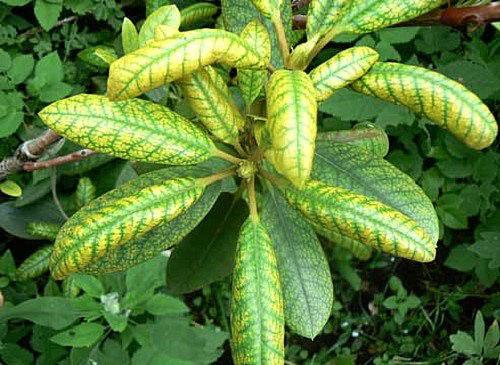Common plant diseases - chlorosis
 Due to the presence of chlorophyll, all plants have a green leaf color. However, it often happens that just yesterday green leaves suddenly begin to lose their color. This is due to a lack of chlorophyll, and the plant disease itself is called chlorosis.
Due to the presence of chlorophyll, all plants have a green leaf color. However, it often happens that just yesterday green leaves suddenly begin to lose their color. This is due to a lack of chlorophyll, and the plant disease itself is called chlorosis.
How does chlorosis manifest in plants?
A symptom of the disease is the "burnout" of the leaf plate. " At first, it only brightens a little, but over time it can turn completely yellow. At the same time, the tips begin to dry out, and even shedding of foliage is possible. The plant itself has a reduced ability to photosynthesis. Young leaves that appear are no longer so large.
Depending on which element is missing, the external signs of chlorosis may have specific features.
The causes of chlorosis
Most often the source plant diseases serve:
- the presence of diseases (viral or infectious);
- lack of certain microelements in the soil;
- increased acidity of the soil, as a result of which plants simply cannot "get" nutrients from it;
- stagnation of water in the root system due to poor drainage, which also makes it impossible to assimilate substances.
If chlorosis is caused by other diseases, it will be very problematic to save green pets.
Common types of chlorosis
In summer cottages, the following types of plant diseases with chlorosis are most often found:
- iron;
- magnesium.
Iron chlorosis is caused by a lack of iron. The leaves in the upper part of the plants turn yellow almost completely, only the veins remain green. Treatment: the simultaneous use of leaf and root dressings with iron preparations. For spraying on a leaf, a solution of ferrous sulfate works well. For watering at the root, you can prepare a chelated form of iron-containing dressing: 0.5 tsp each. Dissolve citric acid and ferrous sulfate in 1 liter of boiled chilled water.
To prevent the disease, it is necessary to feed the plants with the fertilizer "Gilea-antichlorosis".
From the popular methods of preventing iron chlorosis, the use of rusty nails can be distinguished - they are buried in the soil when planting vegetables, flowers, trees, shrubs and other plants.
To acidify the soil, you can dilute citric acid (on the tip of a knife) in 1 liter of water and water the plants every two weeks.
Magnesium chlorosis appears as yellow spots on the leaves at the bottom of the plant. For treatment, it is recommended to use potassium magnesium or magnesium sulfate.
It is useful to know that iron oxides that you recommend to bury in the ground are NOT SOLUBLE !!!
Iron chelate is most commonly used to treat chlorosis. The result is good, tested on personal experience. True, you need to tinker a little. My grapes and pear started to recover after 3 sprays. Now the twigs are growing and the leaves are a rich green color. I also use this preparation for feeding vegetables and flowers.